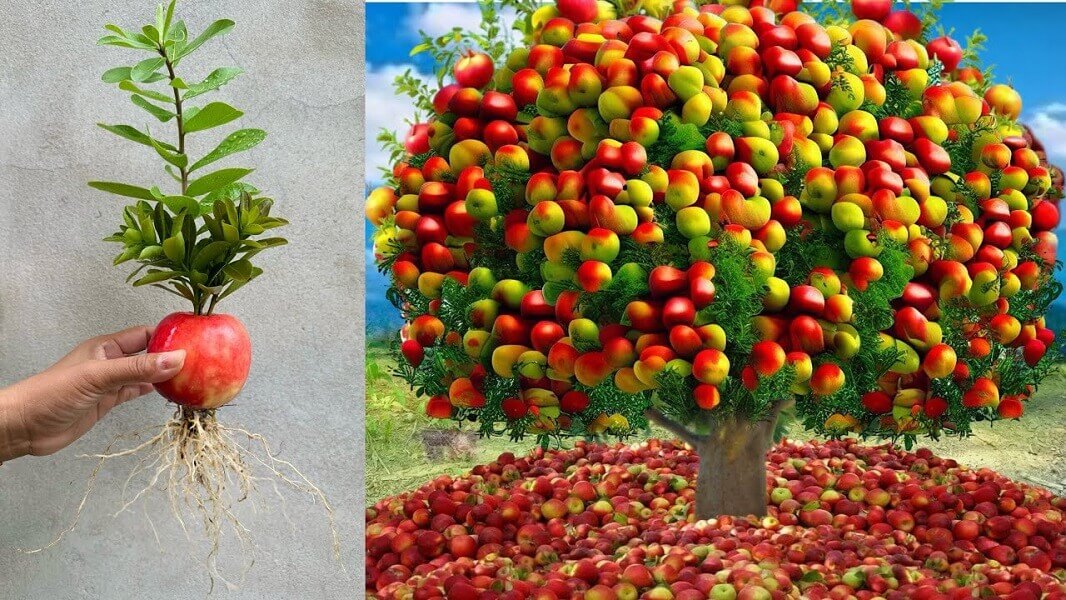Professional Tips and Tricks to Grow Apple Trees

Selecting the appropriate apple tree variety is crucial for successful cultivation. When choosing, consider factors such as climate, soil type, and intended use of the apples. In Britain, popular varieties include ‘Cox’s Orange Pippin’, ‘Bramley’, and ‘Egremont Russet’, each with distinct flavors and growth characteristics. It’s essential to choose a variety that is suited to your specific region and conditions to ensure healthy growth and optimal fruit production.
Planting Location and Soil Preparation
Apple trees thrive in well-drained, fertile soil with a pH between 6.0 and 7.0. Before planting, conduct a soil test to determine the pH and nutrient levels. If necessary, amend the soil with organic matter such as compost or well-rotted manure to improve its structure and fertility. Apple trees require a location with full sun exposure for at least six to eight hours a day. Ensure the site is sheltered from strong winds, which can damage the trees and affect fruit set.
For development to be healthy, proper spacing is also crucial. Planting distances of 15 to 18 feet are recommended for standard apple trees, while spacing of 8 to 10 feet is acceptable for dwarf kinds. Ensuring sufficient space between plants promotes uniform distribution of sunlight and appropriate air circulation, which in turn reduces the risk of illness.
Planting Your Apple Tree
In Britain, apple trees are best planted in the late autumn or early spring, when they are not actively developing, during the dormant season as we read here https://www.chrisbowers.co.uk/category/apples/ .
Before planting a tree, make sure the hole is twice as deep and twice as broad as the root ball. To make it easier for the roots to penetrate, loosen the dirt near the base. Plant the tree in the hole so that the dirt is just above the graft union. Fill the hole with the dirt that was dug out, pressing down gently to remove any air pockets. To help the dirt settle and create contact between the roots and the soil, water it deeply. Lastly, cover the base with mulch to retain moisture, prevent weeds, and control soil temperature.
Watering and Fertilizing
Consistent watering is essential, particularly during the first few years after planting. Young apple trees need regular watering to establish a robust root system. Water deeply, ensuring the soil is moist but not waterlogged. During dry periods, increase the frequency of watering to prevent stress.
As the tree matures, reduce the frequency but continue to water deeply. Established apple trees typically require watering once a week during dry spells. Drip irrigation systems or soaker hoses are effective methods to deliver water directly to the root zone, minimizing evaporation and runoff.
Fertilising apple trees encourages robust development and bountiful harvests. Early in the spring, following the directions on the container, spread a balanced, slow-release fertiliser. Fertilise sparingly; doing so will encourage healthy vegetative growth rather than fruit set. Add compost or well-rotted manure to the fertiliser once a year to keep the soil fertile.
Pruning and Training
Pruning is a critical practice for maintaining the health and productivity of apple trees. It encourages proper structure, removes dead or diseased wood, and improves air circulation within the canopy. The best time to prune apple trees is during the dormant season, from late winter to early spring, before new growth begins.
Start by removing any dead, damaged, or diseased branches. Next, thin out crowded or crossing branches to open up the canopy and allow light to penetrate. Aim to create an open, vase-shaped structure with well-spaced scaffold branches. Regularly remove any suckers or water sprouts that emerge from the base of the tree or along the main branches.
Training young apple trees involves guiding the growth of the main branches to establish a strong framework. Use stakes or training wires to support the branches and encourage them to grow in the desired direction. This practice is particularly important during the first few years after planting.
Pest and Disease Management
Apple trees are susceptible to various pests and diseases, which can affect their health and reduce fruit quality. Implementing an integrated pest management (IPM) approach helps minimize damage and promotes a healthy orchard.
Common pests include aphids, codling moths, and apple maggots. Regularly inspect your trees for signs of infestation, such as curled leaves, chewed fruit, or the presence of larvae. Use natural predators like ladybirds and lacewings to control aphid populations, and apply pheromone traps to monitor and reduce codling moth numbers.
Diseases such as apple scab, powdery mildew, and fire blight can also pose significant threats. To prevent disease, ensure proper spacing and pruning to improve air circulation and reduce humidity within the canopy. Apply fungicides as a preventive measure, particularly during wet weather when fungal spores are most active.
Practicing good sanitation is crucial for disease management. Remove and dispose of fallen leaves, fruit, and pruned branches, as they can harbor pests and pathogens. Maintaining a clean orchard environment reduces the risk of infection and promotes tree health.
Thinning and Harvesting
Thinning fruit is an essential practice to ensure the production of high-quality apples. Apple trees often produce more fruit than they can support, leading to small, undersized apples. Thinning reduces the number of fruits, allowing the remaining ones to grow larger and develop better flavor.
Thin the fruit when they are about the size of a marble, leaving one or two apples per cluster. Ensure even spacing along the branches to prevent them from becoming too heavy and breaking under the weight. Proper thinning also reduces the risk of biennial bearing, where the tree produces a heavy crop one year and little to no fruit the next.
Harvesting apples at the right time is crucial for optimal flavor and storage quality. The ideal harvest time varies depending on the variety and local climate. Generally, apples are ready to harvest when they easily detach from the tree with a gentle twist. The fruit should be firm, with a full color and a slight yield to pressure.
For long-term storage, handle apples carefully to avoid bruising and store them in a cool, humid environment. Properly stored apples can last for several months, providing you with fresh fruit well into the winter.
Overcoming Common Challenges
Growing apple trees in Britain comes with its set of challenges. Unpredictable weather, pests, and diseases can all impact the success of your orchard. Here are some strategies to overcome common issues:
Frost Protection: Late frosts can damage blossoms and reduce fruit set. Protect your trees by covering them with frost cloths or blankets during cold snaps. Alternatively, use orchard heaters or wind machines to raise the temperature around the trees.
Wind Damage: Strong winds can break branches and reduce fruit quality. Plant windbreaks such as hedges or fences to shield your orchard. Additionally, use tree supports and anchors to stabilize young trees.
Waterlogged Soil: Excessive moisture can lead to root rot and other diseases. Ensure proper drainage by planting on raised beds or mounds. Avoid overwatering, especially in poorly draining soils.
Wildlife Damage: Birds and mammals can cause significant damage to apple trees and fruit. Use netting or tree guards to protect your trees from birds. For larger animals, consider installing fencing or using repellents.
Advanced Growing Techniques
For those looking to take their apple-growing skills to the next level, consider these advanced techniques:
Grafting: Grafting allows you to propagate new apple trees from existing ones. It involves joining a scion (a piece of the desired variety) to a compatible rootstock. Grafting can produce trees with improved disease resistance, size control, and fruit quality.
Espalier Training: Espalier is a method of training apple trees to grow flat against a wall or trellis. This technique maximizes space and sunlight exposure, making it ideal for small gardens. Espalier trees also produce high yields of easily accessible fruit.
Organic Growing: Organic apple growing focuses on using natural methods to manage pests and diseases. Employ techniques such as crop rotation, companion planting, and organic sprays to maintain a healthy, chemical-free orchard.
Apple Breeding: For the truly dedicated, breeding new apple varieties can be a fascinating project. Cross-pollinate different varieties to create apples with unique flavors, colors, and growth habits. Keep detailed records of your breeding efforts and evaluate the performance of your new varieties over several years.
Conclusion
Growing apple trees in Britain can be a highly rewarding endeavor, offering the joy of harvesting fresh, home-grown apples and the satisfaction of nurturing a thriving orchard. By selecting the right varieties, preparing the soil, and following best practices for planting, watering, pruning, and pest management, you can ensure healthy growth and abundant fruit production.
Whether you are a novice gardener or an experienced orchardist, the tips and techniques outlined in this guide will help you achieve success. Remember that patience and consistent care are key to cultivating strong, productive apple trees. As you gain experience and confidence, you can explore advanced growing techniques and even experiment with breeding your own unique apple varieties.
Embrace the journey of growing apple trees, and enjoy the delicious fruits of your labor for years to come.






